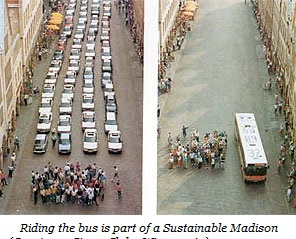|

Good public transit is an important element of a sustainable city. But what does “sustainable” mean? Madison’s 2011 Sustainability Plan defines sustainability “as meeting the current environmental, social and economic needs of our community while ensuring the ability of future generations to meet their needs” (p. 1). And it suggests that “a healthy environment underpins economic and social well-being.” At the end, we question the wisdom of that assertion but suspend our naturally argumentative nature long enough to consider how transit may be part of a healthy environment. It is possible to rattle off a “laundry list” of environmental concerns that could be either alleviated or minimized by traveling by bus instead of by Single Occupancy Vehicle automobile (SOV): air and water pollution, open space and habitat destruction; climate change; energy over-consumption, and fossil fuel consumption to name a few. For many, the issue of climate change is enough to convince them that using public transit is good for the environment. If an individual switches a 20-mile round trip commute to public transportation, his or her annual carbon dioxide emissions can decrease by 4,800 pounds per year, equal to a 10 percent reduction in a typical two-car household’s carbon footprint. On the individual level, EnAct, a community program of Madison Environmental Group, LLC designed to provide individuals and households tips for living in an environmentally sustainable fashion, states in its manual, “Driving less is the most significant action we can take to alleviate local and global environmental problems.” It suggests that before hopping into a car for a Single Occupancy Vehicle ride, people concerned about their ecological footprint should consider walking, biking, ride sharing or taking transit instead. In a step up from individual or household-level action, the Sustainability Plan suggests that Madison should “expand the number of neighborhoods where sustainable transportation choices enable mobility without a car” (p.22) and various Neighborhood Associations have tried to comply. The Schenk-Atwood-Starkweather-Yahara (SASY) neighborhood of about 6,000 residents has an initiative called Sustainable Atwood . One project is the Commute Card, which allows SASY residents to sign up for a bus pass similar to those of employees and students at several major institutions in Madison. Sponsored by Madison Metro Transit and administered by the neighborhood for a $10 annual fee, the card is charged $1.25 every time it is swiped through a fare meter. Neighborhood participants are charged each month for all the rides they took with the card. Could this example be a model to be emulated? Madison’s Sustainability Plan has many transportation-related recommendations for policies on the city level (p.22) including:
What a wish list! It is curious that that list overlaps with that of the Madison Area Bus Advocates in so many ways. However, the words of Jane Goodall at this year’s Earth Day Conference put on by the UW’s Nelson Institute kept echoing. She suggested that the best way to preserve habitat for chimpanzees was to find solutions to the needs of villagers living nearby who might otherwise destroy that habitat in an effort to satisfy their needs. In doing that, not only would the villagers be more satisfied, but the chimpanzees would still have their forest—a “win-win.”
The point? In an interdependent world, economic and social well-being may underpin a healthy environment as much
as a healthy environment may underpin economic and social well-being. Fortunately, good public transportation is an
important element of all three sustainability components.
|
